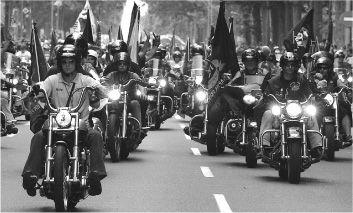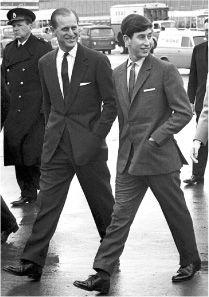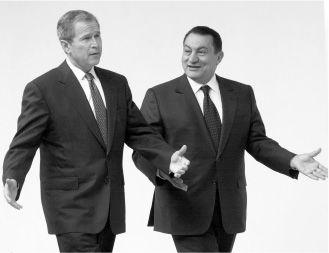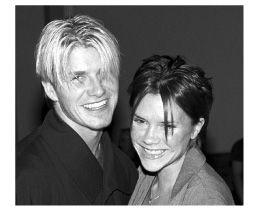The Definitive Book of Body Language (40 page)
Read The Definitive Book of Body Language Online
Authors: Barbara Pease,Allan Pease

On your marks, get set: in the starting blocks— readiness to end an encounter or a conversation
The body-language signals covered in this chapter are fairly easy to observe because most involve big gestures. Not only is it important to understand the significance of these signals, it's vital to good communication that you eliminate any negative gestures from your own repertoire and practice using the things that will give you positive results.
MIRRORING—HOW WE
BUILD RAPPORT

They all look the same, dress the same way, use the same facial expressions
and body language, but each will tell you he's “doing his own thing”
When we meet others for the first time, we need to assess quickly whether they are positive or negative toward us, just as most other animals do for survival reasons. We do this by scanning the other person's body to see if they will move or gesture the same way we do in what is known as “mirroring.” We mirror each other's body language as a way of bonding, being accepted and creating rapport, but we are usually oblivious to the fact that we are doing it. In ancient times, mirroring was also a social device that helped our ancestors fit in successfully with larger groups; it is also a leftover from a primitive method of learning that involved imitation.
One of the most noticeable forms of mirroring is yawning— one person starts and it sets everyone off. Robert Provine found that yawning is so contagious you don't even need to see another person yawn—the sight of a wide-open mouth is enough to do it. It was once thought that the purpose of yawning was
to oxygenate the body but we now know that it's a form of mirroring that serves to create rapport with others and to avoid aggression—just as it also does for monkeys and chimps.
Wearing the same outfit as another woman
is a mirroring no-no. But if two men show up
at a party wearing the same outfit, they
could become lifelong friends.
Nonverbally, mirroring says, “Look at me; I'm the same as you. I feel the same way and share the same attitudes.” This is why people at a rock concert will all jump to their feet and applaud simultaneously or give a “Mexican Wave” together. The synchronicity of the crowd promotes a secure feeling in the participants. Similarly, people in an angry mob will mirror aggressive attitudes and this explains why many usually calm people can lose their cool in this situation.
The urge to mirror is also the basis on which a queue works. In a queue, people willingly cooperate with people they have never met and will never see again, obeying an unwritten set of behavioral rules while waiting for a bus, at an art gallery, in a bank or side by side in war. Professor Joseph Heinrich from the University of Michigan found that the urges to mirror others are hardwired into the brain because cooperation leads to more food, better health, and economic growth for communities. It also offers an explanation
as to why societies that are highly disciplined in mirroring, such as the British, Germans, and ancient Romans, successfully dominated the world for many years.

Learning to mirror our parents begins early: Prince Philip and a young Prince Charles in perfect step
Mirroring makes others feel “at ease.” It's such a powerful rapport-building tool that slow-motion video research reveals that it even extends to simultaneous blinking, nostril-flaring, eyebrow-raising, and even pupil dilation, which is remarkable as these microgestures cannot be consciously imitated.
Studies into synchronous body-language behavior show that people who feel similar emotions, or are on the same wavelength and are likely to be experiencing a rapport, will also begin to match each other's body language and expressions. Being “in sync” to bond with another person begins early in the womb when our body functions and heartbeat match the rhythm of our mother, so mirroring is a state to which we are naturally inclined.
When a couple are in the early stages of courtship it's common to see them behave with synchronous movements, almost as if they are dancing. For example, when a woman takes a mouthful of food the man wipes the corner of his mouth; or he begins a sentence and she finishes it for him. When she gets PMS, he develops a strong desire for chocolate; and when she feels bloated, he farts.
When a person says “the vibes are right” or that they “feel right” around another person, they are unknowingly referring to mirroring and synchronous behavior. For example, at a restaurant, one person can be reluctant to eat or drink alone for fear of being out of sync with the others. When it comes to ordering the meal, each may check with the others before ordering. “What are you having?” they ask as they try to mirror their meals. This is one of the reasons why playing background music during a date is so effective—the music gets a couple to beat and tap in time together.

Mirroring the other person's body language and appearance shows a united
front and doesn't let either get one-up on the other
American heart surgeon Dr. Memhet Oz reported some remarkable findings from heart recipients. He found that, as with most other body organs, the heart appears to retain cellular memories, and this allows some patients to experience some of the emotions experienced by the heart donor. Even more remarkably, he found some recipients also assume the same gestures and posture of the donor even though they have never seen the donor. His conclusion was that it appears that the heart cells instruct the recipient's brains to take on the donor's body language. Conversely, people suffering from disorders such as autism have no ability to mirror or match the behavior of others, which makes it difficult for two-way communication with others. The same goes for drunk people whose gestures are out of sync with their words, making it impossible for any mirroring to occur.
Because of the phenomenon of cause and effect, if you
intentionally
assume certain body-language positions you will begin to experience the emotions associated with those gestures. For
example, if you feel confident, you may unconsciously assume the Steeple gesture to reflect your confidence, but if you intentionally Steeple you will not only begin to feel more confident, others will perceive that you're confident. This, then, becomes a powerful way to create a rapport with others by intentionally matching their body language and posture.
Geoffrey Beattie, at the University of Manchester, found that a woman is instinctively four times more likely to mirror another woman than a man is to mirror another man. He also found that women mirror men's body language, too, but men are reluctant to mirror a woman's gestures or posture—unless he is in courtship mode.
When a woman says she can “see” that someone doesn't agree with the group opinion, she is actually “seeing” the disagreement. She's picked up that someone's body language is out of sync with group opinion and they are showing their disagreement by not mirroring the group's body language. How women can “see” disagreement, anger, lying, or feeling hurt has always been a source of amazement to most men. It's because most men's brains are simply not well equipped to read the fine detail of others' body language and don't consciously notice mirroring discrepancies.
As we said in our book
Why Men Don't Listen and Women Can't Read Maps
(Orion), men and women's brains are programmed differently to express emotions through facial expressions and body language. Typically, a woman can use an average of six main facial expressions in a ten-second listening period to reflect and then feed back the speaker's emotions. Her face will mirror the emotions being expressed by the speaker. To someone watching, it can look as if the events being discussed are happening to both women.
A woman reads the meaning of what is being said through the speaker's voice tone and his emotional condition through his body language. This is exactly what a man needs to do to capture a woman's attention and to keep her interested and listening. Most men are daunted by the prospect of using facial feedback while listening, but it pays big dividends for the man who becomes good at it.
Some men say, “She'll think I'm effeminate!” but research with these techniques shows that when a man mirrors a woman's facial expressions as she talks, she will describe him as caring, intelligent, interesting, and attractive.
Men, on the other hand, can make fewer than a third of the facial expressions a woman can make. Men usually hold expressionless faces, especially in public, because of the evolutionary need to withhold emotion to stave off possible attack from strangers and to appear to be in control of their emotions. This is why most men look as if they are statues when they listen.
The emotionless mask that men wear while listening allows them to feel in control of the situation, but does not mean men don't experience emotions. Brain scans reveal that men can feel emotion as strongly as women, but avoid showing it publicly.
The key to mirroring a man's behavior is in understanding that he doesn't use his face to signal his attitudes—he uses his body. Most women find it difficult to mirror an expressionless man, but with males this is not required. If you're a woman, it means that you need to reduce your facial expressions so that you don't come across as overwhelming or intimidating. Most important, don't mirror what you think he
might
be feeling. That can be disastrous if you've got it wrong and you may be described as “dizzy” or “scatterbrained.” Women in business who listen with a more serious face are described by men as more intelligent, astute, and sensible.
When two people live together for a long time and have a good working relationship, they often begin to look alike. This is because they are constantly mirroring each other's facial expressions, which, over time, builds muscle definition in the same areas of the face. Even couples who don't look facially similar can appear similar in a photograph because they use the same smile.
